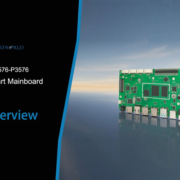What Is an Embedded Motherboard?
An embedded motherboard is a specialized type of computer motherboard designed to serve as the foundation for embedded systems. These systems are dedicated to specific tasks or functions, such as controlling machinery, monitoring data, or powering consumer electronics, and they are commonly found in a wide range of industries—from industrial automation to healthcare devices, digital signage, automotive electronics, and smart home technology.
In this article, we’ll explore what embedded motherboards are, their key features, and how they differ from traditional motherboards.
What Is an Embedded System?
To understand an embedded motherboard, it’s first essential to understand what an embedded system is. An embedded system is a computer designed to perform a specific function or set of functions within a larger system. Unlike general-purpose computers (like desktops or laptops) that can run multiple applications and operate in diverse environments, embedded systems are highly specialized. They typically operate with real-time constraints, are resource-constrained, and often interact with sensors or actuators.
Common examples of embedded systems include:
- Smart thermostats
- Medical devices (e.g., heart rate monitors)
- Automotive control units
- Industrial robots and machinery
- IoT devices
The embedded motherboard is the core component of these systems, providing the processing power, communication interfaces, and connectivity required for these specialized applications.
Key Features of an Embedded Motherboard
An embedded motherboard typically offers a range of features that set it apart from conventional motherboards:
- Compact Form Factor
Embedded motherboards are designed to fit into small enclosures. These form factors are often smaller than standard desktop motherboards, enabling them to integrate into compact devices or systems. Common embedded form factors include Mini-ITX, Pico-ITX, PC/104, and Qseven. - Low Power Consumption
Many embedded systems need to run for long periods or continuously. Therefore, embedded motherboards are optimized for low power consumption. This is particularly important in battery-operated devices or systems where energy efficiency is crucial. - Long Lifecycle and Stability
Embedded systems often have long lifecycles because they are typically used in industrial, automotive, or medical applications, where reliability and longevity are essential. Embedded motherboards are designed with these long-term stability and extended availability in mind. As a result, manufacturers tend to continue producing these components for many years, unlike traditional consumer-grade products that may go obsolete quickly. - Customizable and Application-Specific
Embedded motherboards can be customized to fit the needs of specific applications. These customizations could include specific connectors, I/O ports, or the integration of special components like field-programmable gate arrays (FPGAs) or application-specific integrated circuits (ASICs). - Durability and Robustness
Embedded motherboards are often designed to withstand harsh environments, such as high temperatures, humidity, and shock, making them ideal for industrial and automotive applications. Many embedded motherboards are built with ruggedized components that allow them to function reliably in these demanding settings. - Support for Specialized Interfaces
Unlike traditional desktop motherboards that mainly support USB, HDMI, and Ethernet, embedded motherboards often include interfaces specific to the embedded world, such as RS-232/RS-485 serial ports, CAN bus, GPIO pins, and LVDS (Low Voltage Differential Signaling) for connecting sensors and other devices. - Real-Time Performance
Many embedded systems require real-time performance, where data must be processed and acted upon within a set timeframe. Embedded motherboards often support real-time operating systems (RTOS), ensuring that the system meets strict timing requirements in mission-critical applications like robotics or medical devices.
Embedded Motherboards vs. Traditional Motherboards
While both embedded motherboards and traditional motherboards serve as the central hub for a computer system, there are several key differences between the two:
| Feature | Embedded Motherboard | Traditional Motherboard |
|---|---|---|
| Purpose | Designed for specialized, dedicated functions | Designed for general-purpose computing |
| Size | Typically smaller (Mini-ITX, Pico-ITX, etc.) | Larger form factors (ATX, Micro ATX, etc.) |
| Power Consumption | Optimized for low power consumption | Power consumption depends on the system’s needs |
| Customization | Highly customizable for specific applications | Generally not customized, more standardized |
| Lifespan | Long lifecycle with stability for industrial use | Shorter lifecycle with frequent updates |
| I/O Connectivity | Specialized I/O ports (serial, CAN bus, GPIO) | Standard I/O ports (USB, HDMI, Ethernet) |
| Reliability | Built for rugged, long-term use | May not be as rugged or stable for long-term use |
While traditional motherboards are designed for a broad range of applications—gaming, office productivity, media creation—embedded motherboards are engineered to meet the specific needs of specialized systems that demand long-term reliability, low power, and flexibility.
Applications of Embedded Motherboards
Embedded motherboards can be found in a wide range of industries, including:
- Industrial Automation
Embedded motherboards are commonly used in PLC (programmable logic controller) systems, industrial robots, and machine control systems, where precision and reliability are crucial for automation processes. - Medical Devices
Many medical devices, such as patient monitoring systems, ultrasound machines, and medical imaging equipment, rely on embedded motherboards for their real-time data processing and power efficiency. - Automotive Systems
Embedded systems control numerous functions in modern vehicles, from infotainment systems and GPS navigation to ADAS (Advanced Driver Assistance Systems) and engine control units (ECUs). - Consumer Electronics
Smart TVs, smart home devices, and set-top boxes are often powered by embedded motherboards, providing the connectivity and processing power required for seamless user experiences. - Digital Signage
Embedded motherboards are widely used in digital signage solutions, where they drive content on displays in retail stores, transportation hubs, and other public spaces. - Internet of Things (IoT)
Many IoT devices, such as smart thermostats, connected security cameras, and wearable devices, rely on embedded motherboards for their small form factor, low power, and communication capabilities.
An embedded motherboard is the backbone of an embedded system, providing all the necessary computing power, connectivity, and flexibility required to operate specialized applications. Whether you’re working on industrial machinery, medical equipment, automotive electronics, or smart home devices, embedded motherboards offer the reliability, durability, and performance needed to support these mission-critical systems.



